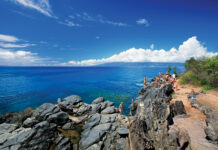Kilauea Iki erupted for just over a month, then stopped despite what scientists knew was still a full underground reservoir of magma. Weeks later, that molten rock found an outlet down the east rift that stretches along Kilauea’s flanks through the district known as Puna. I remember watching residents of the village of Kapoho shovel cinders from their roofs in a vain attempt to save their houses. Already, the fountaining vent had killed their papaya and coffee trees, and soon creeping lava would destroy the little town.
Pele has been wiping out parts of Puna for centuries. One famous ancient story tells of the time Pele sent her little sister Hi‘iaka to Kaua‘i to fetch Pele’s lover Lohiau back home to Hawai‘i. Pele gave her sister forty days to accomplish this task and warned her to keep her hands off the handsome Lohiau.
As she set off on the perilous journey, Hi‘iaka asked her sister to watch over her beloved lehua groves and her friend Hopoe in Puna. When Hi‘iaka finally reached Kaua‘i, Lohiau was dead; Hi‘iaka had to spend precious time reviving him. Alas, she missed the deadline and arrived home to find her lehua forests in flame and Hopoe wrapped in burning lava, victims of Pele’s suspicion and jealousy.
Many other beloved sites have been destroyed by Pele, one of whose names is Pele-ai-honua: Pele, eater of land. Roads, heiau, black-sand beaches, emerald-green pools, the entire community of Kalapana—all have disappeared beneath the inexorable advance of lava.
Though neighboring volcano Mauna Loa erupted in 1984, most of the land eating these days is done by Kilauea, which has erupted sixty-six times since the national park was established in 1916. Even the volcano’s name acknowledges its constant eruptive power; Kilauea means “spewing, much spreading.”
Since 1983, the action has been on Kilauea’s flanks, from a cinder cone named Pu‘u ‘O‘o. Over the years, this ever-changing eruption has allowed hardy hikers to approach in relative safety as it poured into the ocean from different points along the coast. I was able to hike amazingly close to one of these flows soon after the Pu‘u ‘O‘o eruption began.





